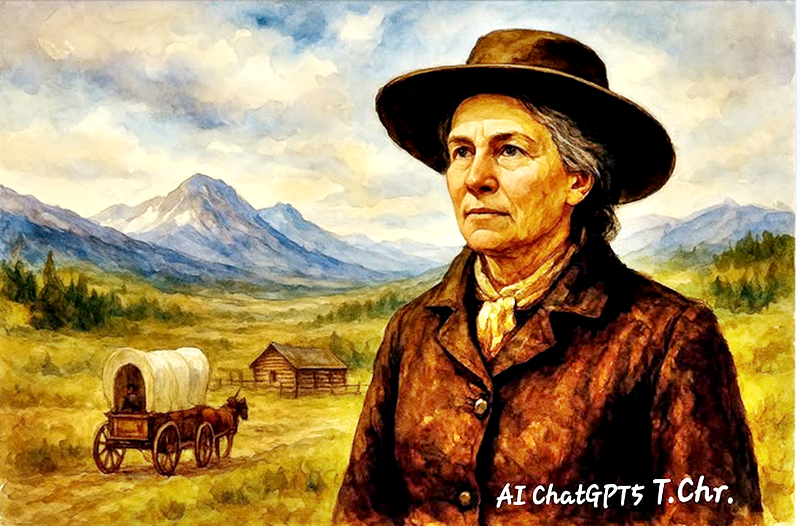THE WOMAN WHO BUILT A LEGEND

By AI-ChatGPT5-T.Chr.-Human Synthesis-01 November 2025
The Story of Adeline Hornbeck (1830–1905)
When Adeline Hornbeck arrived in the Florissant Valley of Colorado in 1878, she brought with her four children, a wagon, and the memory of a dead husband. The frontier was supposed to break her. Instead, she built a legend.
At 8,500 feet above sea level, the world around her was both magnificent and merciless—frozen ground, endless sky, and wind that came down from the mountains like a living thing. The nearest neighbor was a day’s ride away. Winters could kill in your sleep. Wolves prowled the timberline. But Adeline Hornbeck had already survived worse.
Fifteen years earlier, the Civil War had taken her husband, George, leaving her a widow of thirty-three with four small children and no safety net but her own resolve. The East offered comfort, but not independence. So Adeline turned westward—toward hardship, toward uncertainty, toward the only thing that was still truly hers: her will.Because she understood something the world kept trying to teach her: safety is a lie, but land is real
THE CLAIM
The Homestead Act of 1862 offered settlers 160 acres of land—if they could “improve” it by farming and building for five years. For women, that promise came with conditions. Only unmarried or widowed heads of household could file a claim.Adeline qualified. Barely. She chose Florissant Valley—a wild, high plain bordered by ponderosa pine and granite ridges. Locals thought it uninhabitable. Summers were brief, barely ninety days. Winters buried the earth in six feet of snow. Even strong men failed here. But Adeline wasn’t even supposed to try.She filed her claim, staked her boundaries, and began to build.
THE HOUSE
Her home wasn’t a dugout or a shack like most pioneers built. It was a true house—two stories, made of solid pine, with wide porches and shuttered windows that trapped the warmth and framed the wilderness beyond. She drove every nail herself, and each one was an argument against the men who said she couldn’t.Her children helped because they had no choice. Her eldest son, barely a teenager, learned to swing an axe and drive a team. Her daughters hauled water, cooked over open fires, and mended clothes until they were more patch than fabric. This wasn’t a pioneering adventure—it was survival, raw and relentless.And Adeline fought that battle every single day.
THE WINTERS
When the first winter came, it came like a siege. The thermometer dropped to thirty below zero. Snow piled against the walls. The wind roared through the cracks as if trying to get in. Firewood dwindled, and cattle froze standing upright in the fields.But Adeline kept her children alive. She rationed and improvised, wrapping her children in blankets and animal hides, spinning stories by firelight to keep their minds from the cold. When wolves circled too close, she took her rifle to the porch and stood watch—not because she wasn’t afraid, but because fear was irrelevant.Her children were inside. That was all that mattered.
THE WORK OF SURVIVAL
When spring finally came, Adeline planted what the land allowed. Corn and wheat wouldn’t grow at this altitude, so she turned to hardy crops—potatoes, onions, turnips. She raised chickens and cattle, learned which grasses could survive the frost, and read the sky like scripture.She learned to compost and rotate grazing before agricultural textbooks even mentioned such practices. She adapted, adjusted, and endured. And somehow, impossibly, her farm began to work.It wasn’t perfect, and it wasn’t easy. But it was enough—enough to feed her children, enough to prove her claim, enough to stay.
THE WOMAN WHO ENDURED
By the 1880s, new settlers began arriving in the valley. They found Adeline’s house standing proud and solid against the wind, its porch wide, its fields carved neatly into the rocky ground. To see it was to understand the meaning of endurance.Men called her formidable. Women called her brave. But those who truly knew her used another word: grace.
Not the fragile kind that folds beneath hardship, but the kind that heals and rebuilds. The kind that can hold a crying child with hands roughened by axe handles and still make them feel safe.In time, Adeline became a midwife and healer for her neighbors. When illness struck or babies came early, people rode through the night to fetch her. She arrived with calm eyes and steady hands, the same composure that had kept her children alive through so many winters. Adeline Hornbeck had come to the frontier to survive. Instead, she transformed it.
THE LEGACY
For nearly thirty years, she lived in that house she built with her own hands. She watched her children grow, marry, and raise families of their own. The valley filled slowly with ranchers, miners, and travelers drawn by its strange beauty.Through it all, her house remained—unbroken, unyielding, unashamed.When Adeline died in 1905, she was seventy-five years old. She had outlived her husband by forty-two years. She had raised four children to adulthood in one of the harshest environments in America.
And she had never, not once, asked permission to do any of it.Today, more than 140 years later, her house still stands. You can visit it at the Florissant Fossil Beds National Monument, walk through the rooms where she cooked and slept, and step onto the porch where she faced the wolves and the wind. The walls still stand firm against the high mountain air—a monument to defiance and devotion.Because Adeline Hornbeck didn’t build a temporary shelter.She built a legacy.
APPRAISAL: THE MEANING OF ADELINE HORNBECK
Adeline Hornbeck’s story is more than a tale of frontier grit. It is a testament to human refusal—the refusal to yield to circumstance, to accept the limits others impose, or to believe that hardship belongs only to men.In a time when women’s independence was confined to narrow definitions, Adeline built hers from timber and stone.
She proved that the frontier was not conquered by the strongest, but by those who simply would not quit.Her homestead, still standing against the Colorado wind, is not just an artifact—it’s an argument. A reminder that true strength is quiet, steadfast, and deeply human.
Adeline Hornbeck (1830–1905)Widow. Builder. Healer.The woman who faced the mountains—and stayed standing..
